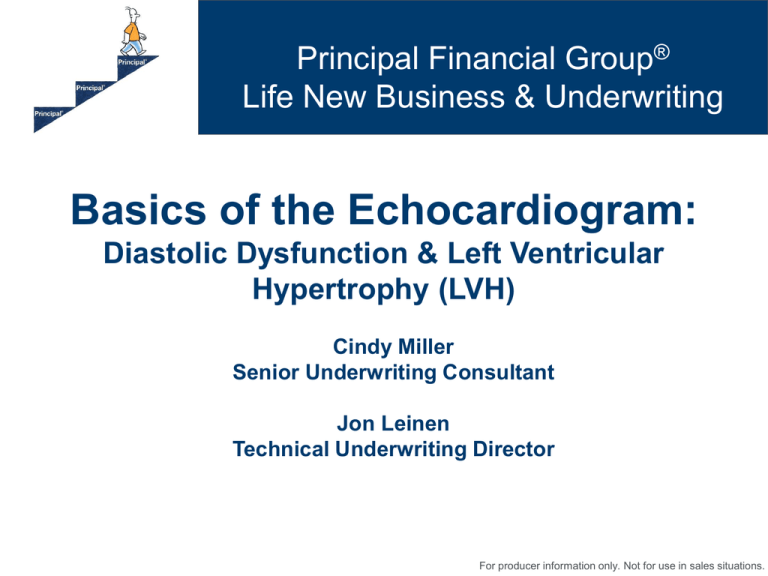Principal Basics of the Echocardiogram Diastolic
advertisement

Principal Financial Group® Life New Business & Underwriting Basics of the Echocardiogram: Diastolic Dysfunction & Left Ventricular Hypertrophy (LVH) Cindy Miller Senior Underwriting Consultant Jon Leinen Technical Underwriting Director For producer information only. Not for use in sales situations. The Echo History • The technology of sonar or echosonography was originally developed during World War II to detect submarines • The first “echo” was in the early 1950s. A Swedish physicist borrowed a sonar device from a local shipyard, modified it, and recorded echo’s from his own heart For producer information only. Not for use in sales situations. The Echo Uses of the Ultrasound (US) • Gynecology and obstetrics • Vascular issues • Musculoskeletal issues • Detection of tumors in various areas in the body: prostate, colon, breast, heart, gastointestinal tract and other organs • Cardiology For producer information only. Not for use in sales situations. The Echo Cardiac Arena used for: • Identification of structures of the heart (normal and abnormal) • Allows for assessment of the motion and function of the heart and it’s various structures • Follows blood flow through the heart and measures velocity of the blood flow • Serves as a compliment to other diagnostic tests (eg. confirms EKG findings for LVH or chest x ray finding; can be helpful assessing degree of coronary plaque - via US that is done simultaneously with cath.) For producer information only. Not for use in sales situations. The Echo How is it completed? • It involves a US machine, a wand which is known as a transducer that is connected to a US machine • The patient lies on stretcher and the echosonographer who has been specifically trained in techniques of echosonography performs the scan • The scan is completed in a very systematic format to obtain specific views of the heart that the cardiologists expects to see on any given echo For producer information only. Not for use in sales situations. The Echo • 3 inter-related processes utilized during an ECHO – M mode – 2-D component – Doppler (continuous wave/pulses wave/ color flow) For producer information only. Not for use in sales situations. The Echo M Mode – Single dimension picture – Enables us to look closely and measure the heart chambers and structures, the aorta (helpful with LVH, myxomatous valves, valvular stenosis, hypertrophic & dilated cardiomyopathies) – Can also play a role in the assessment of some valve functions For producer information only. Not for use in sales situations. The Echo M Mode (LVID and Wall measurements / MV motion) For producer information only. Not for use in sales situations. The Echo 2D Mode – Two dimensional picture of the heart is produced as result of sound waves going out of the transducer and bouncing off a structure and then returning back to the transducer 2D - 4 Chamber apical view Diastole Systole MV open MV closed For producer information only. Not for use in sales situations. The Echo 2D -parasternal For producer information only. Not for use in sales situations. The Echo Doppler Mode – Evaluates the path of the blood flow – Evaluates the blood flow velocity as it moves through the heart and its structures 3 Types Doppler : – Pulsed Wave – Continuous Wave – Color Flow For producer information only. Not for use in sales situations. The Echo Pulsed Wave Doppler Measures velocity of blood as it moves through the heart • Helps to assess how heart muscle squeezes (systole) & relaxes (diastole) E/A ratio For producer information only. Not for use in sales situations. The Echo Continuous Wave Doppler • Measures blood flow velocity as it moves through the valves • Measure degree of valvular regurgitation measuring the density, length and shape of the wave forms • Helps to quantify how severely a valve is leaking For producer information only. Not for use in sales situations. The Echo Continuous Wave Doppler Aortic Insufficiency Mitral Regurgitation • CW- Aortic Regurg For producer information only. Not for use in sales situations. The Echo Color Flow Doppler • Measures the velocity and direction of blood flow via color patterns For producer information only. Not for use in sales situations. The Echo Color Flow Doppler MV Open MV Closed For producer information only. Not for use in sales situations. The Echo Putting it all together • During the test the images that have been obtained (M mode/2 D images and Doppler) are recorded for later viewing by the MD • The technician writes a report of their interpretation of the findings and prepares the report and a recording of the entire echo for the MD to review • MD provides a final analysis from the recording/the interpretation For producer information only. Not for use in sales situations. The Echo What Underwriters should note when reviewing the report: • Why was it completed? • Patient data (being aware of the persons age/any disease processes/body size ) • Quality of the image • Assess the entire report and try not to focus on just one aspect ***** • Do the findings make sense with the overall clinical picture? ***** For producer information only. Not for use in sales situations. The Echo Limitations & Variables • Interpretation of the echo can be somewhat subjective • Body habitus and other physical deformities can alter the findings and ability to accurately obtain some of the images • Equipment variables • Sonographer technique and experience • Some of the findings can’t be reproduced and are time specific For producer information only. Not for use in sales situations. The Echo Additional Considerations • Don’t take an isolated reading and automatically rate it, instead consider the following… – Compare to prior echos – Take age and body habits into consideration – Note the BP and other impairment history – Note why the test was done in the first place – What if any clinical signs/symptoms are present – What other clinical data is present that support the findings For producer information only. Not for use in sales situations. The Echo Common Abnormal Echo Findings • LVH • Concentric (hypertension, valve diseases, aortic stenosis, cardiomyopathies, obesity) • Asymmetric Septal Hypertrophy (ASH), Valve disease • Abnormal Wall Motion • Global hypokensis (HK) (cardiomyopathies) • Segmental HK or akinesia (AK) (ischemic heart disease) • Dyskinesia (aneurysms, LBBB) For producer information only. Not for use in sales situations. The Echo Common Abnormal Echo Findings cont… – Abnormal Valves - stenosis , insufficiency, bicuspid AV – MAC (Mitral annular calcification), thickened cusps, calcium deposits – Diastolic dysfunction – PFO / ASD – Atrial Enlargements (valve disease, diastolic dysfunction or atrial fib) – Aortic Root enlargements (CTD, valve disease) For producer information only. Not for use in sales situations. The Echo Less Common Findings… • Tumors (malignant or benign) • Pericardial effusions • Congenital defects (great vessel anomalies) For producer information only. Not for use in sales situations. The Echo Normal findings on a typical Elderly person .. • LV wall thickness increases 15%; • LV mass increases 1 gm/yr from ages 65-80 – senile septum ( septum thickens slightly ) • LA dimensions increase ~ 16% For producer information only. Not for use in sales situations. The Echo Normal findings on Elderly person cont… • LV dimension unchanged • Aortic Root diameter increases ~ 22% • E/A velocity is often reversed ( diastolic dysfunction ) • Valvular disease and MAC For producer information only. Not for use in sales situations. The Echo Normal Dimensions / Adult 2D-Echo Right ventricular dimension (RVD) 1.9 - 2.8 Left ventricular end diastolic dimension (LVEDD) 3.5 - 6.0 Left ventricular end systolic dimension (LVESD) 2.1 - 4.0 Posterior LV wall thickness (PW) 0.6 - 1.1 Interventricular septum wall thickness (IVS) 0.6 - 1.1 Mild enlargement 1.2 – 1.3 Mod 1.4 – 1.5 Severe 1.6 – 1.7 Left atrial dimension (LA) 1.9 - 4.0 Aortic root dimension (AR) 2.0 - 3.7 Cusp separation - aortic valve 1.5 - 2.6 Fractional shortening (FS) 25 – 42% Ejection fraction (EF) 50 – 59% Pulmonary Artery Pressure (RSVP) Up to 40 For producer information only. Not for use in sales situations. Echocardiogram Reference RangesLeft Atrium Female Normal Range Mildly Abnormal Moderately Abnormal Severely Abnormal LA Diameter, cm 2.7 – 3.8 3.9 – 4.2 4.3 – 4.6 ≥ 4.7 LA Diameter BSA, cm 1.5 – 2.3 2.4 – 2.6 2.7 – 2.9 ≥ 3.0 ≤ 20 21 – 30 31 – 40 ≥ 40 22 – 52 Normal Range 53 – 62 Mildly Abnormal 63 - 72 Moderately Abnormal ≥ 73 Severely Abnormal LA Diameter, cm 3.0 – 4.0 4.1 – 4.6 4.7 – 5.2 ≥ 5.3 LA Diameter BSA, cm 1.5 – 2.3 2.4 – 2.6 2.7 – 2.9 ≥ 3.0 ≤ 20 21 – 30 31 – 40 ≥ 40 18 – 58 59 – 68 69 - 78 ≥ 79 LA Area LA Volume, ml Male LA Area LA Volume, ml Women and Men: LA Volume Index: Normal ≤ 28 ml/m²; Mild to Moderate- 29-39ml/m²; Severe- >40 ml/m² For producer information only. Not for use in sales situations. Diastolic Dysfunction LEFT VENTRICULAR DYSFUNCTION • The Basics – The heart is a pump: it has to be able to fill up (diastole) and then it has to be able pump the blood out (systole) • Systolic dysfunction – Pump failure equates to a low Ejection Fraction (EF) Cardiomyopathy / CAD – Heart muscle is damaged and is unable to pump the blood out to the body normally For producer information only. Not for use in sales situations. Diastolic Dysfuntion Diastolic dysfunction • LV can’t fill normally due to impaired relaxation/or restriction • Ventricular systolic function is preserved • Incidence increases with age and is seen in some degree in at least 50% of older patients • More prevalent in women • Signs and symptoms may be the same as in systolic failure For producer information only. Not for use in sales situations. Diastolic Dysfunction Pathophysiology of Diastolic dysfunction: • Normally the LV is passively filled, and then the atria contract and that provides additional “atrial packing.” • In diastolic dysfunction the left ventricle cannot fill up with blood normally due to a hard stiff and non compliant LV and the blood has to be forced in For producer information only. Not for use in sales situations. Diastolic Dysfuntion Causes of Diastolic Dysfunction • Aging - lose general elasticity • HTN - general wear and tear on the heart muscle causing it to hypertrophy and become stiff • Aortic stenosis - LV becomes stiff because it’s overworked • MI - scarring, damaged muscle • Ischemic heart disease - damaged muscle • Obesity - increases the workload and the muscle hypertrophies and becomes stiff and non compliant For producer information only. Not for use in sales situations. Diastolic Dysfuntion Prognosis • Depends on the degree of diastolic dysfunction • If severe, can be as grim as systolic failure For producer information only. Not for use in sales situations. Diastolic Dysfunction Signs & Symptoms • Shortness of Breath / Dyspnea on Exertion • SM and or S4 present • Pedal edema • Systolic Hypertension • Increased proBNP (brain naturetic peptide - hormone made by the heart that increases when the heart is stressed For producer information only. Not for use in sales situations. Diastolic Dysfuntion Echo findings that support diagnosis of Diastolic Dysfunction: • Abnormal E/A ratio – – E/A ratio is the ratio between passive filling and active filling of the LV (normally the E wave is 80% process and A wave is 20%; in diastolic dysfunction this ratio is reversed) For producer information only. Not for use in sales situations. Diastolic Dysfunction Normal E/A ratio First spike = E wave / Second smaller spike = A wave . For producer information only. Not for use in sales situations. Diastolic Dysfunction Diastolic Dysfunction – Equates to reversed E/A ratio (smaller E wave - taller A wave) For producer information only. Not for use in sales situations. Diastolic Dysfunction Four Echocardiographic Patterns of Diastolic Dysfunction • Grade I – Abnormal relaxation – Reversal of E/A ratio – Some of this is normal with aging – No significant clinical signs or symptoms For producer information only. Not for use in sales situations. Diastolic Dysfuntion Four Echocardiographic Patterns of Diastolic Dysfunction • Grade II – Pseudo-normal filling (poorer prognosis at this stage) – Moderate diastolic dysfunction – Clinical symptoms apparent as well as have LAE and increased filling pressures – Having more symptoms of SOB and possibly some edema – Decreased exercise capacity For producer information only. Not for use in sales situations. Diastolic Dysfunction • Grade III - IV Diastolic Dysfunction – Restrictive filling – Advanced diastolic dysfunction – Left Atrial enlarged significantly – May also have reduced EF – This would be diastolic heart failure rather than systolic failure. (Often hard to differentiate whether its systolic or diastolic failure at this because of the complex issues at play and it’s probable they could be experiencing both at this point) For producer information only. Not for use in sales situations. Diastolic Dysfuntion Treatment Treat the cause / reduce the workload…… • Control hypertension • Control the heart rate - maximize diastole/filling period (beta blockers) • Improve LV relaxation (calcium channel blockers/ace inhibitors/angiotensin receptor blockers) • Decrease the resistance the heart pumps against (afterload) and or decrease the filling pressure/pre-load by use of vasodilators • Monitor build and salt intake • Lose weight and exercise • Regular follow up For producer information only. Not for use in sales situations. The Echo: Case Study #1 – 73 male NS – 72 inches 260 # – NIDDM & HTN. – Six months ago went to Emergency room complaining of SOB. No chest pain or palpitations. Last year had EBCT calcium score 10. – BP 180/100 – Grade II/VI SEM ; S4 – 2 + Pedal edema – Ecg increased voltage – Chest x-ray mild cardiomegaly For producer information only. Not for use in sales situations. Case Study Echo - Mild Aortic stenosis - EF 50% - Reversed E/A ratio - IVS-1.2 ; PW-1.3 - LVID 5.6; LA 4.6 - Right sided chambers mildly dilated. - Mild TR and RSVP 39 For producer information only. Not for use in sales situations. Case Study RECAP ----Indicators that he may have significant diastolic dysfunction – NL EF and still having unexplained symptoms not otherwise accounted for by another disease – Age and build – Long standing htn not optimally controlled – AS – S4 ( noncompliant ventricle) For producer information only. Not for use in sales situations. Left Ventricular Hypertrophy (LVH) LVH … Ecg- increased voltage on the ecg tracing – Chest x-ray- cardiomegaly – Echocardiogram- measurement of the thickness of the LV wall The most specific test for LVH is from the echo For producer information only. Not for use in sales situations. LVH • Normal LV wall thickness: 0.6 cm to 1.1 cm • LVH (LV wall thickness) • Mild: 1.2-1.3 cm • Moderate: 1.4-1.5 cm • Severe: 1.6-1.7 cm • Extreme: >1.7 cm For producer information only. Not for use in sales situations. LVH • 2 measurements to look for on the echocardiogram for LVH: • Posterior LV wall thickness (PW) - normal -0.6 - 1.1 • Interventricular septum wall thickness (IVS) - 0.6 - 1.1 For producer information only. Not for use in sales situations. LVH For producer information only. Not for use in sales situations. LVH • What is 1 cm wide? For producer information only. Not for use in sales situations. LVH • Not much in actual difference between 1.0 and 1.7 cm. However there is very significant mortality risk with this relatively small difference when talking about the left ventricle wall thickness For producer information only. Not for use in sales situations. LVH • Concentric - enlargement of the wall that is the same for both the posterior wall and the septal wall • Asymetrical - differences in thickness of the walls. 10% of cases, left ventricular hypertrophy may manifest on echocardiograms in an asymmetric – May indicate possible hypertrophic cardiomyopathy For producer information only. Not for use in sales situations. Causes of LVH • Hypertension • Heart valve disorder such as aortic valve stenosis • Ischemia • Cardiomyopathy • Nutritional disorder • Endocrine disorder • Congenital heart disease • Toxins- alcohol, drugs For producer information only. Not for use in sales situations. What is LV Mass • Takes into account gender and size of the individual as well as LVEDd, PWT, and IVS to determine the relative size (mass) of the LV • Increased LV mass is also associated with an increased risk for sudden cardiac death • Measurements of LV mass must be interpreted in the clinical context • In clinical practice, however, the presence of LVH is more commonly defined by wall thickness For producer information only. Not for use in sales situations. LVH: Assessment How do we assess LVH? • Look for underlying cause, any clinical symptoms/findings- primary reasons for LVH are hypertension and valve disorder • Mild- as good as standard/preferred, depending on history • Moderate- likely mildly to moderate ratable • Severe- highly rated, if we can offer For producer information only. Not for use in sales situations. Contact for Questions Contact information: Cindy Miller: Miller.cindy@principal.com PH: 515-235-9285 Jon Leinen: Leinen.jon@principal.com PH: 515-247-6672 For producer information only. Not for use in sales situations. Questions For producer information only. Not for use in sales situations.








